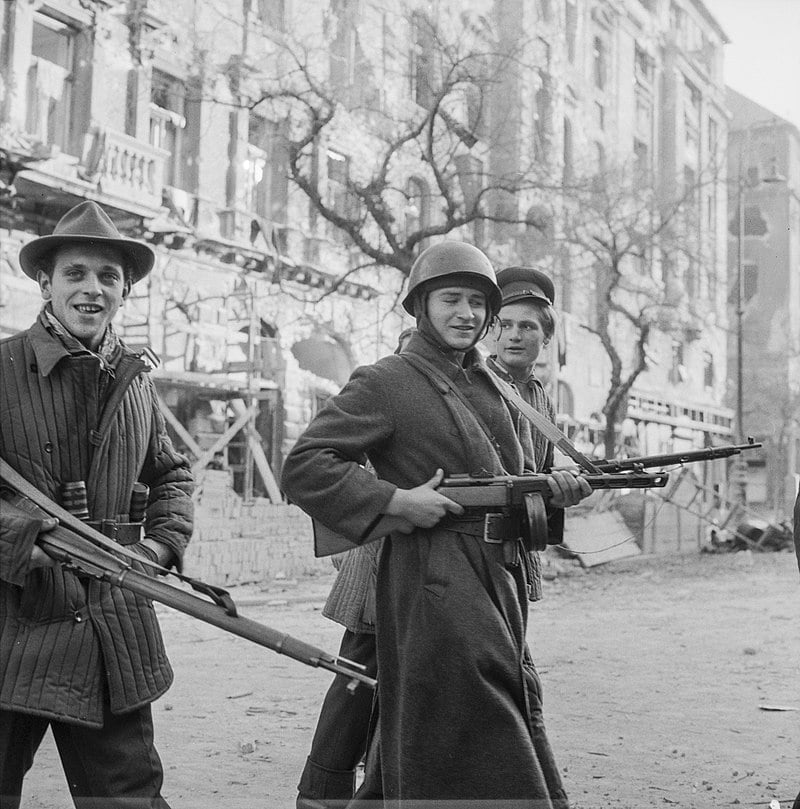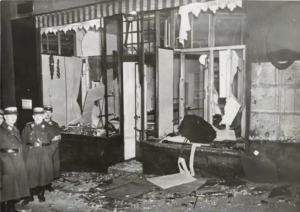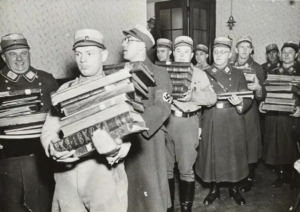
Foundation for the History of Totalitarianism
Winning essay in the 2023-24 essay competition

Pastor Martin Niemöller’s famous poem, First They Came [1] was written as a confession after the Nazis fell from power. It succinctly describes how the Nazis’ repression of political opposition was ignored by most Germans. The lack of political opposition led to escalating repression in the pre-war period, building up to the antisemitic pogrom known as Kristallnacht in 1938. The poem describes how totalitarian ideologies can only succeed and repress their subjects through ordinary people’s apathy and indifference. The poem begins:
“First they came for the communists and I did not speak out, because I wasn’t a communist.”
Hitler’s early support came from multiple groups. The middle and upper classes were scared of the new Bolshevik government in Russia and the electoral success of the German Communist Party, so they felt pushed towards voting for Hitler. He was able to gain votes from the working class due to the Great Depression. Support for the Nazis jumped 34 per centage points to 37 per cent between the 1928 and July 1932 elections. Others who had lost out in the new Weimar Republic such as monarchists, landowners and industrialists came to support Hitler’s nationalist and pro-business platform. With the support of these diverse groups, Adolf Hitler was appointed chancellor in January 1933. Those who had helped Hitler come to power turned a blind eye to the violence on the streets, where Hitler’s private army, a gang of “misfits, thugs and murderers” known as the Brownshirts or the SA (standing for Sturmabteilung, literally “Storm Division”), fought against communists.
One of Hitler’s first acts of terror as chancellor came in February 1933. In what Hitler described as “a sign from God”, he used an arson attack against the Reichstag (the German parliament) as a catalyst for a wave of anti-communist repression. Left-wing members of parliament were barred from the Reichstag. Over 4,000 people were arrested and tortured by the SA. Multiple articles of the German constitution were suspended, ending Germany’s brief stint of freedom of the press, of opinion, assembly and communication. [2] Six days later, in the March 1933 elections, many people were so afraid of the Communists or attracted to Hitler’s promise to end unemployment, that Hitler gained 92 seats, giving the two far-right parties a majority in the Reichstag.
“Then they came for the socialists and I did not speak out because I wasn’t a socialist.”
Hitler saw democracy as “one of the most serious signs of decay of mankind.” He saw the individuality expressed in Weimar Germany as a sign of weakness. Consequently, in March 1933, he attempted to pass the Enabling Act, which would turn Germany into a dictatorship, legitimising the Nazi terror that was to follow. As a constitutional amendment, the Act required two-thirds of parliament to approve it. It was useful for Hitler that 107 out of 648 deputies were currently held in Nazi custody and thus unable to vote. The act was passed after Hitler convinced the Catholic Centre Party that he would not abuse his power and would protect certain rights of the Catholic Church. The Supreme Court did not challenge the law, instead they were “convinced of the legitimacy of the process.” [3] Germany was now, after a brief 15-year period of freedom, a totalitarian state. The act allowed Hitler to pass any law he wanted, without the approval of the Reichstag.
The final step towards a repressive totalitarian state was the “Night of the Long Knives”, when leading Nazis opposed to Hitler, including the leader of the SA and a former chancellor, were brutally murdered one weekend in a deadly purge. Hitler justified it by saying that these murders were necessary to return Germany to its former glory. The real goal was to remove the SA as a political force in Germany and increase his personal control.
The first concentration camp – Dachau – was opened in March 1933, initially to hold political opponents of the Nazi regime. These were mostly members of the German Communist Party, the socialist SPD party and trade unionists. At Dachau, practices developed such as forced labour that became standard for future concentration camps. The Nazis attempted to extract as much productivity as possible from the inmates, regardless of the physical and mental impact on them. The concentration camps became an important tool for the Nazis, scaring potential dissidents whilst punishing those who actively opposed them.
“Then they came for the trade unionists and I did not speak out because I wasn’t a trade unionist.”
Profession by profession, the Nazis embarked on a policy known as Gleichschaltung (meaning “Coordination”), the purpose of which was to create a repressive one-party state where all elements of society were under Nazi control. Firstly, non-Aryans were banned from the civil service in April 1933. Then, workers were forced to join the German Labour Front and barred from joining normal trade unions, striking or collectively bargaining. Next, in 1935, the workbook system was introduced, recording employment status, without which you could not be legally employed. Employers held their employees’ workbooks, which made it impossible for them to change jobs without the approval of their bosses.
The teachers’ branch of the German Labour Front, the Nazi Teachers Association, required teachers to teach Nazi ideas. The curriculum was changed to reflect these ideas with the goal of creating a generation that would support the party. Finally, in 1937, all judges who refused to rule in favour of the Nazi party were forcefully retired, granting the Nazis full authority over the judiciary.
“Then they came for the Jews and I did not speak out because I wasn’t a Jew.”
The Nazis heavily repressed many social groups, blaming them for Germany’s woes. The disabled and the elderly were considered a financial strain on the state. The Nazis considered gay men degenerates, subverting the Aryan race. Black and mixed-race Germans were forcefully sterilised on Hitler’s direct orders to prevent racial mixing. However, the most heavily persecuted group in Nazi Germany were the Jews. In every element of society, Jews were marginalised: fake racial pseudoscience became an important subject in the school curriculum; children in the Hitler Youth were taught that Jews were the reason for Germany’s recent woes; Jews were stripped of their wealth and dignity; and they became victims of continually growing violence.
Antisemitic persecution in Germany had multiple motives. One was an attempt to gain economic benefit. Forced labour in concentration camps became increasingly used from 1937. For example, Mauthausen Concentration Camp was built in 1938 near a quarry to meet the demand for stone. Inmates were often fed less food than they needed to replenish the energy used by manual labour. This was to save money and led to death through labour. Even Jews who weren’t sent to concentration camps still lost their jobs, creating openings for German men and reducing the unemployment rate.
But the main motive was the antisemitism of Hitler himself and others. The ‘Stab-in-the-back’ myth blamed Jews for Germany losing the First World War, while stereotypes of ‘Greedy Jews’ perpetuated the idea that Jews were to blame for the Great Depression. As the historian, Lucy Dawidowicz put it, “The Jews, the accusations went … had cushy jobs behind the front; Jews were profiteering out of the war.” [4] In reality, Jews were overrepresented in the German army and the First World War was lost due to military issues. But many Germans accepted these reactionary arguments as fact. Dawidowicz drew a line from here to the Holocaust, believing that the repressions of 1933-39 were steps on a path to allowing Hitler to achieve his ultimate goal of annihilation of the Jewish race. Alternatively, it could be argued that the antisemitic repression was, at this point, primarily intended to encourage Jews to emigrate out of Germany.
Repression of Jews markedly increased almost immediately after the Enabling Act of 1933, with an SA-enforced boycott of Jewish business, which almost turned into a pogrom. This was internationally condemned, with mass protests across the western world, but, domestically, the boycott was presented as a preventative measure to prevent spontaneous violence. [5] In March and April, Jews were banned from holding most jobs in the civil service, courts, and professions. Then, sweeping legal changes were introduced in 1935 with the racist and antisemitic Nuremburg laws. The first, the Reich Citizenship Law, limited German citizenship to those with four German grandparents, taking citizenship away from not just Jews but also black and Roma people. This law created a legal underclass who were ‘subjects’ of the Reich, rather than citizens. The second, the Law for the Protection of German Blood and German Honor, banned sexual relations and marriages between Germans and non-Germans, a severe regression from the relative freedom enjoyed under Weimar Germany. In 1937, Hitler personally ordered the sterilisation of over 500 children to stop race mixing, and the castration of 174 gay men to cure them of ‘degeneracy’. [6]
In 1938, repression reached a new peak with a violent attempt to scare Jews into leaving Germany. By January, many Jews were reliant on aid to keep them alive, with no access to education or opportunity to practice their religion. The Nazis removed Jews from the economy by seizing Jewish businesses and any property valued over 5,000 Reichsmarks. Jews were stripped of their rights as tenants and were unable to receive benefits from the state. Then, on November 9, 1938, a nationwide pogrom began called Kristallnacht. So-called spontaneous looting, destruction and burning of Jewish homes, businesses and synagogues was so damaging that the streets were littered with glass. Joseph Goebbels, the Minister for Propaganda, depicted the violence as a justified reaction by the German people to the assassination of a German diplomat. Really, it was regional Nazi officials who ordered stormtroopers and party supporters to begin the violence. In the chaos, 30,000 people were arrested and sent to concentration camps. However, whilst the violence emulated that of the Brownshirts in 1933, there was more support from ordinary Germans, including children. Jews were beaten or publicly humiliated, and at least 91 were killed over the two nights.

The extreme repression successfully convinced Jewish people to emigrate. In the last two years before the war, repression had become so extreme that over 100,000 left the country, 20% of the total Jewish population. Individual Nazi officers were able to enrich themselves by exploiting the desperation of Jews to leave the country, accepting bribes of cash or personal possessions in return for accelerated immigration papers. Those who had been arrested in the pogrom were required to leave the country in return for being released from concentration camps. In the aftermath of the pogrom, Jews were even more removed from society, banned from public spaces such as restaurants or even certain streets. The Jewish community was also forced to give up over 2 billion Reichsmarks for damages caused by Nazi supporters during Kristallnacht. [7]
“Then they came for me and there was no one left to speak out for me.”

The Nazis wanted complete control over ordinary people’s lives. To protect the regime from being overthrown they had to quickly identify dissidents. People lived in constant fear of being reported to the secret police force, the Gestapo. Children in the Hitler Youth were encouraged to report anti-Nazi sentiments expressed by their parents. Major international cultural influences such as jazz music, Bauhaus architecture and books with Jewish authors were all banned to stop different ideas entering the country. The history of repression in Nazi Germany is indicative of how totalitarian regimes can take full political and social control of a country to repress its population.
Pastor Martin Niemöller is a prime example of this: like many Germans, he supported the Nazis as they came to power but by the time he realised the true nature of the party, it was too late. He was arrested and imprisoned without trial in 1937 after criticising the regime. He was illegally held for eight months and sent to Sachsenhausen concentration camp, where he barely survived the Second World War.
Most Germans were not rabid National Socialists.[8] However the fact that only a tiny minority meaningfully opposed National Socialism enabled Nazi rule. Most Germans were apathetic to the destruction and evil brought about by the Nazis. With antisemitic and Islamophobic crimes on the rise across the world, it is incredibly important to oppose all forms of discrimination. If people do not speak up, it is conceivable that repression on the scale of that in Nazi Germany could appear again.
BY SAM TILLER
COLCHESTER ROYAL GRAMMAR SCHOOL
Please note that this essay should not be regarded as a “model essay” or example to be imitated. The Foundation welcomes essays written in different styles.
[1] Niemöller M (1946) First They Came
[2] GHDI. (1933) Reichstag Fire Decree. Available at: https://germanhistorydocs.ghi-dc.org/sub_document.cfm?document_id=2325.
[3] United States Holocaust Memorial Museum. Available at: https://encyclopedia.ushmm.org/content/en/article/the-enabling-act
[4] L Dawidowicz (1991) The War Against the Jews: 1933-1945. Page 45
[5] L Dawidowicz (1991) The War Against the Jews: 1933-1945. Page 53
[6] R Evans (2006) The Third Reich in Power, Page 528
[7] R Evans (2006) The Third Reich in Powter, Chapter 6
[8] E Johnson, K Reuband (2006) What We Knew: Terror, Mass Murder, and Everyday Life in Nazi Germany / An Oral History. Page 331
See more winning essays